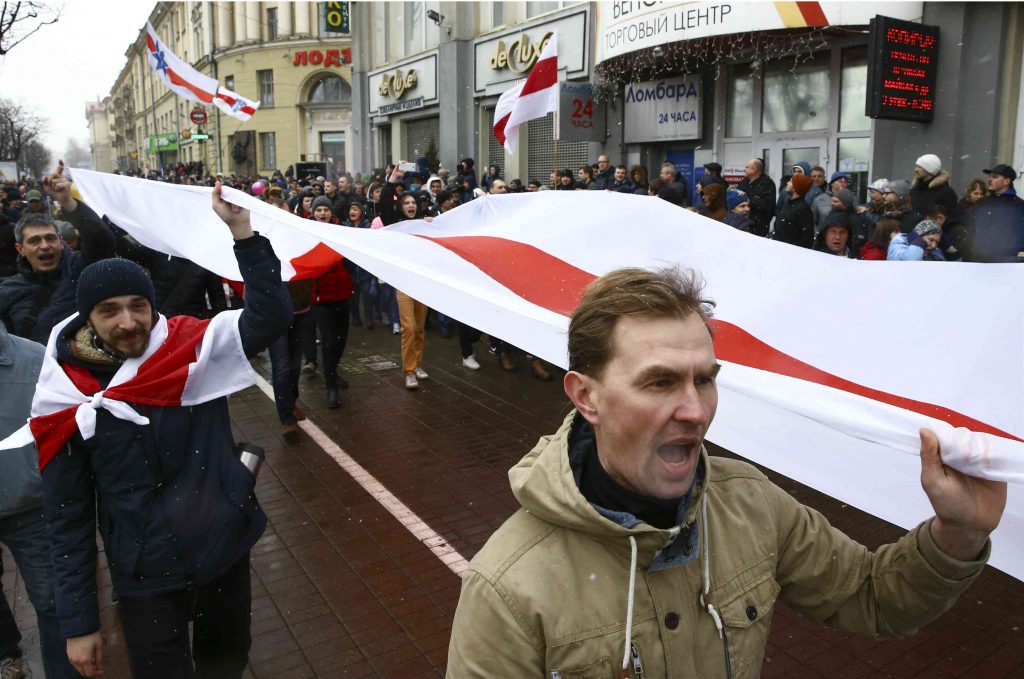The brief honeymoon between Belarus and the West is over after a brutal crackdown last month in Minsk. Almost one thousand people were detained, many were beaten and jailed—including international journalists and human rights defenders—and dozens may face long-term imprisonment on trumped-up charges. State propaganda claims that protesters were involved in “extremist activities supported by Ukraine, Poland, and the West in general.”
The explanation that has been given to the West is different: it’s all Russia’s fault. According to Belarusian officials, Russia inspired the protests to destabilize Belarus and damage its recently improved relationship with the West. After all, Russia wants to keep Belarus in its orbit.
Both explanations are wrong.
The unprecedented demonstrations that occurred in thirteen Belarusian cities throughout February and March were unexpected. The initial street protests in February were organized by ordinary people and directed against the newly-enforced “tax on parasites,” a 2015 decree that fines people $250 who work less than 183 days annually. However, it immediately turned into a political protest, with demands that President Alexander Lukashenka resign. The crowd held signs with symbols of independence: white-red-white flags, and the pro-independence slogan “Žyvie Biełaruś” (“long live Belarus”). There were no pro-Russian symbols in the crowds. The Washington Post got it right: society is sick of Lukashenka’s prison and “won’t be silenced.”
Lukashenka responded predictably: all of the national and regional opposition leaders who might shape the spontaneous protests were arrested and detained.
Before the key street rally in Minsk on March 21, Lukashenka spoke about the recent detention of an “extremist” group reportedly preparing provocations; the group was detained after his announcement. All of those detained were middle-aged men who were involved in a patriotic Belarusian group (Biely Lehijon or White Legion) fifteen or twenty years ago, a group that stopped its activities long ago. The most characteristic feature is that they speak Belarusian and sell books in Belarusian. At the same time, no Russian “Cossacks” or members of Russian organizations operating in Belarus have been arrested.
A wave of protests recently broke out in Russia as well. On March 26, approximately 100,000 Russians went to the streets in more than ninety cities, from Kaliningrad to Vladivostok, in anti-government rallies. There were some similarities between the recent Russian and Belarusian protests, and not just in terms of the governments’ brutal responses. In both countries, the outlying regions were involved; the protests were decentralized and independent of the demoralized structures of the old opposition.
The protests in Russia have direct implications for Belarus: The Russian crackdown showed that the country’s internal problems are getting sharper, and the Kremlin will likely not have enough resources to continue its financial support of Lukashenka’s regime. Lukashenka will be faced with unprecedented anger even from his traditional electorate. Without cheap energy resources, he will have trouble supporting the huge state sector, including giant law enforcement structures such as the police apparatus and the KGB.
In advance of the 2018 Russian presidential election, some have speculated that Putin needs another Crimea-like stunt to keep his numbers up, and land grabs in Belarus and northern Kazakhstan have been mentioned as possibilities. However, considering the recent protests in Russia and the mood on the street in Belarus, Lukashenka’s overthrow, followed by the establishment of a more malleable Kremlin protégé and then the annexation of Belarus—all to shore up Putin’s electoral standing—seem far-fetched. Even a short and successful war against Belarus would not hide Russia’s glaring problems of poverty and corruption. Periodic anti-Belarus rhetoric in the Russian media should be seen as justification to reduce its financial aid to Lukashenka and shorten his leash, not overtures to gobble it up.
Some in the West believe that there are two wings around Lukashenka: one Soviet-conservative, pro-Moscow flank represented mainly by generals, and another that is liberal and pro-Western. But that is not the case; for many years, Russia has failed to create a strong, pro-Kremlin “fifth column” in Belarus. Although Moscow consistently finances a number of pro-Russian, pseudo-orthodox, paramilitary initiatives in Belarus, they remain small. Their only strategic ally is Lukashenka’s regime itself: the state has a monopoly on pro-Russian attitudes.
Recently, to prove his loyalty to Russia, Lukashenka said that the joint Russia-Belarus military exercises Zapad-2017 should not be a source of fear; instead, they secure Belarus’ independence against threats coming from the West, he said.
In 2016, the EU and the United States lifted sanctions on Belarus, pointing to an improved human rights record. The recent protests demonstrate that the government’s temporary “liberalization” consisted simply of well-prepared, cosmetic actions that included no real institutional changes. Lukashenka can’t change his autocratic approach, and he remains part of the post-Soviet space. The sooner the West wakes up to this reality, the better.
Francišak Viačorka is new media editor of RFE/RL’s Belarusian Service and director of communications at the Belarusian Institute of America. He tweets @franakviacorka.
Image: People take part in a procession, denouncing the new tax on those not in full-time employment and marking the 99th anniversary of the proclamation of the Belarussian People's Republic, in Minsk, Belarus, March 25, 2017. REUTERS/Vasily Fedosenko
